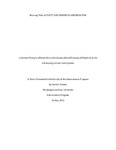Unilateral Primary Afferent Nerve Cut Causes Altered Pruning of Dendrites in the Developing Central Taste System (thesis)

View/
Author
Doobin, David James
Subject
Washington and Lee University -- Senior Thesis in Neuroscience
Chemical senses -- Research
Dendrites -- Growth
Developmental neurophysiology
Metadata
Show full item recordDescription
Thesis; [FULL-TEXT FREELY AVAILABLE ONLINE] David James Doobin is a member of the Class of 2011 of Washington and Lee University. The development of the taste system mirrors that of other sensory systems, and thus an understanding of gustatory developmental phenomena can provide insight into developmental processes in general. Changes in taste stimulus‐driven activity during gustatory development are dynamic: step‐wise maturation of taste buds, age‐related alterations in taste primary afferent nerve responsiveness, and alterations in patterns of synaptic connections in the nucleus of the solitary tract all occur during a protracted postnatal period. We hypothesized that these structural and functional changes help to shape the dendritic morphology of the neurons located in the nucleus of the solitary tract (NTS), the sole site of peripheral taste sensory input, specifically by reducing the complexity of these dendritic arbors, i.e., that dendritic ‘pruning' occurs in response to patterned taste activity. This was investigated by unilaterally cutting the lingual tonsilar branch of the glossopharyngeal nerve – which projects to the NTS – in 18 day old hamsters
and using Golgi‐Cox staining to examine dendritic morphology of NTS neurons at three post nerve‐cut survival times. NTS neurons were traced and dendritic segment length was analyzed along with dendritic node quantity and cell body area for two defined classes of neurons in the NTS. It was found that animals in the shortest survival time group (31 days post‐nerve cut, or 49 days‐old) had neurons with significantly longer dendritic branch lengths, more dendritic branch nodes, and increased cell body area in the NTS ipsilateral to glossopharyngeal nerve cut. This effect disappeared when animals were allowed to survive
65 days following nerve cut. (83 days‐old). This result suggests that the loss of afferent input induces a reversible delay in normal dendritic pruning. We speculate that delayed pruning may occur consequent to axonal sprouting and rearrangement of the terminal fields of the remaining two major taste nerves. This would compensate for the lack of afferent synaptic activity and initiate late stage pruning of the dendritic arbors. David J. Doobin